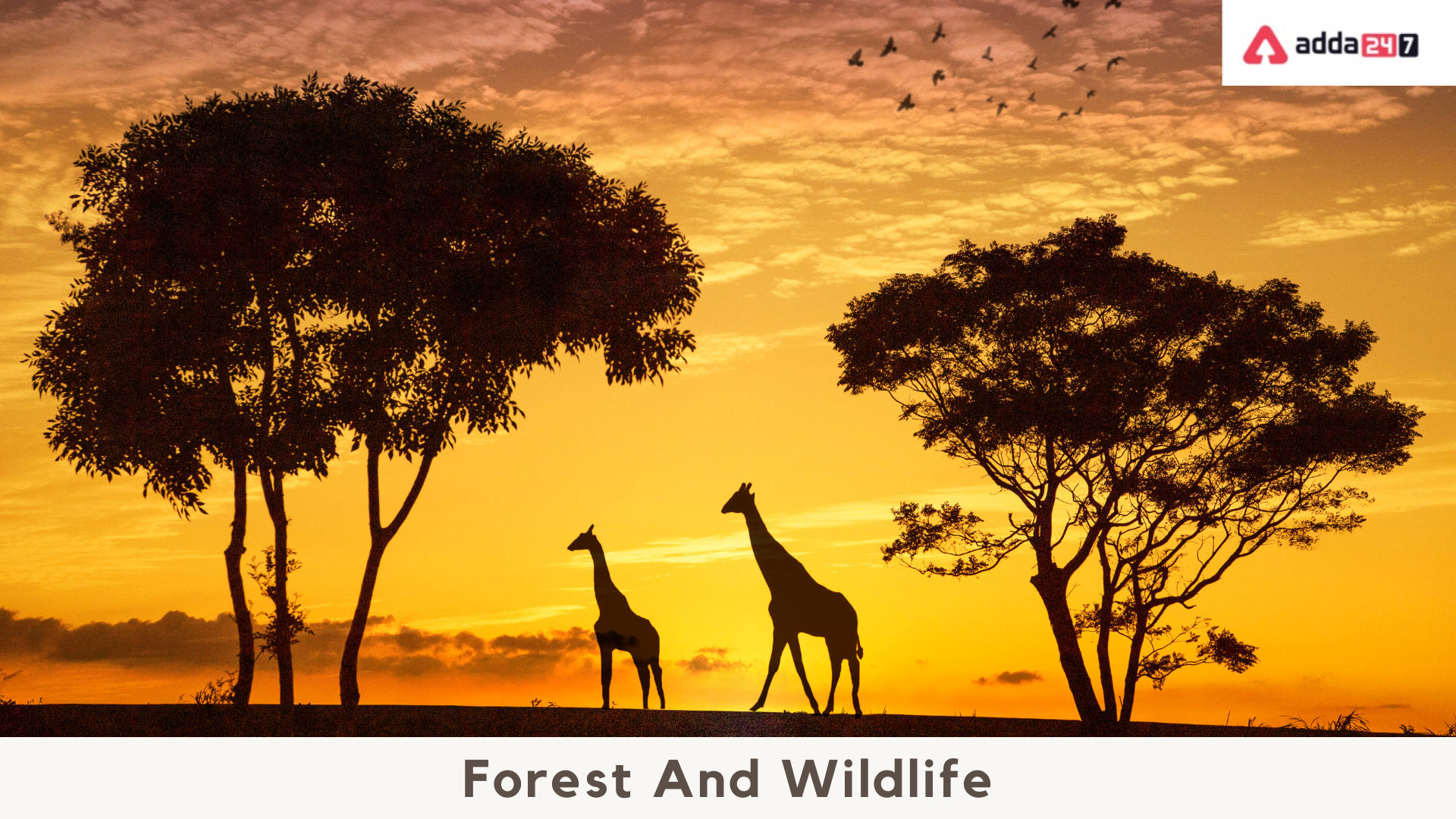Table of Contents
Forest and Wildlife Resources Class 10 Notes– Meaning, Effects & Protection
Forest and Wildlife Resources Class 10 Notes are given in this article. In the environment, forests and wildlife are interconnected. A forest is a big region of land dominated by trees, aquatic biomes, multiple species of animals, and a million different microorganisms. Many wild animals can be found in the forests.
Conservation of forests and wildlife is necessary to keep the population of different animal and bird species in check. Primary, secondary, and tertiary consumers can be found in the forest food chain. We should plant more trees and prohibit hunting and tree cutting. In the following article, we will learn more about forests and wildlife, as well as how to conserve them. Read Full Forest and Wildlife Resources Class 10 Notes.
Forest and Wildlife Resources Class 10 Notes- What are Biodiversity, Forest and Wildlife Resources?
The word “Bio” refers to “life,” and “diversity” refers to “forms.” Occurrence of different types of ecosystems, different species of organisms with a whole range of variants (biotypes), and genes adapted to different climates environments along with their interactions and processes.
Forest and Wildlife Resources Class 10 Notes- Flora and Fauna In India
If we look around us, we will find a variety of plants and animals. Flora refers to the plant population, whereas fauna refers to the animal population. India is one of the world’s richest and most diversified countries in terms of its vast arrangement of biological diversity.
- This is possibly twice or thrice the number yet to be discovered.
- These diverse flora and fauna in India are so well integrated into daily life that we take these for granted.
- But, lately, they have been under great stress. About 10% of India’s recorded wild flora and 20% of its mammals are threatened.
- Many flora and fauna would now be categorized as ‘critical,’ that is on the verge of extinction, such as forest spotted owlet, cheetah, pink-headed duck, mountain quail, madhuca insignis (Mahua), etc.
Class 10 students can now join the board exam preparation batch by Adda247 and ace their board exam.
Forest and Wildlife Resources Class 10 Notes- Significance of Forests
Why are Forests Considered as Biodiversity Hotspots?
Forest is home to a variety of species and organisms. We can come across different life forms found in forests such as plants, insects, wildflowers, birds, ferns, herbs, shrubs, bacteria, fungi, nematodes, reptiles, etc. Hence the forests are considered biodiversity hotspots. Forests have a very high level of species richness and large biodiversity of endangered species, many highly endemic. To maintain ecological stability, we should aim to preserve biodiversity.
Forest and Wildlife Resources Class 10 Notes- Stakeholders
Stakeholders are the different groups of people who are interested in the conservation of forest and wildlife.
- Local People: The people living in forests depend on many resources like wood, timber, etc. Wood for cooking of food and to make themselves warm during winter seasons. They collect the dried wood or only cut the branches of trees to make their huts. These people do not harm the forests, and they know how to take care of forests since it’s their homes.
- Industrialists: Industrialists depend on forest products such as raw materials like wood, leaves, jutting branches, etc. They supply to various industries like lac industry, paper industry, timber industry, etc., leading to deforestation. The industrialists do not depend on only one area to extract raw materials.
- Forest Department of Government: The forest department owns the lands of the forest and systematically controls the forest resources.
- Wildlife and Nature Enthusiasts: The people are not dependent on the forest for any sort of resources, but they conserve the forest resources in their original condition without any spoilage.
Forest and Wildlife Resources Class 10 Notes- Factors Responsible for the Depletion of Forest and Wildlife
- Agricultural Expansion: After 1947, agricultural expansion continues to be one of the major causes of the depletion of forest resources. Between 1951 and 1980, the Forest Survey of India, over 26,200 sq. km. of forest area was converted into agricultural land all over India.
- Colonial Rule: The greatest damage inflicted on Indian forests during this time was due to the expansion of the railways, agricultural lands, commercial and scientific forestry, mining activities, etc.
- Development Projects: Since 1951, over 5,000 sq km of forest was cleared for river valley projects. Clearing forests continues with projects like the Narmada Sagar Project in Madhya Pradesh, which would inundate 40,000 hectares of forest.
- Shifting Agriculture: Substantial parts of the tribal belts, especially in northeastern and central India, have been deforested or degraded by shifting cultivation (jhum), a type of slash and burn agriculture.
- Mining: It is another essential factor behind deforestation. The ongoing dolomite mining seriously endangers the Buxa Tiger Reserve in West Bengal. It has disturbed the natural habitat of various species and blocked the migration route of several others, including the great Indian elephant.
- Grazing and Fuel-wood Collection: Overgrazing leads to the destruction of forests and soil erosion. But a substantial part of the fuel-fodder demand is met by lopping rather than entire felling trees.
Forest and Wildlife Resources Class 10 Notes- Forests and Wildlife Conservation
To decrease or prevent deforestation and conserve forests and wildlife, the government has implemented various rules, methods, and policies.
- Sanctuaries, national parks, and biosphere reserves have been considered where activities like plantation, cultivation, grazing, hunting, poaching, etc., are prohibited.
- Sanctuary is where animals and their habitats are safe from any external disturbances with very limited human activities.
- Wildlife sanctuaries are the places where killing animals and cutting trees are prohibited.
- Wildlife sanctuaries have protected many endangered species like blackbuck, white-eyed buck, elephant, golden cat, pink-headed duck, gharial, marsh crocodile, python, rhinoceros, etc.
- There are few well-known sanctuaries in India like Corbett National Park in Uttarakhand, Ranthambore National Park in Rajasthan, etc.
- National parks are where animals can use their habitats and natural resources freely. Some of the well-known national parks in India are Bandipur National Park in Karnataka, Keoladeo Ghana National Park in Rajasthan, etc.
- Biosphere reserves are places to conserve wildlife, animals, plants, the traditional life of tribes, etc. These are the specific regions that signify the conservation of biodiversity.
- The biosphere reserve conserves the biodiversity and culture of that particular area.
- Growing trees (afforestation) on barren land can conserve forests and wildlife. Van Mahotsava is an act of planting trees twice a year by government and voluntary agencies.
- Replanting trees (reforestation) in the damaged or cleared areas helps conserve forests.
- Grazing should be controlled according to the availability of pasture.
Join the Adda247 Saksham batch by clicking on this link.
Forest and Wildlife Resources Class 10 Notes- Effects of Deforestation
- Cutting down trees leads to soil erosion due to heavy winds and rainfall. The removal of topsoil due to erosion leads land to infertile soil.
- Removal of forests in large numbers makes the land barren and dry thus, leading to desertification.
- Deforestation leads to the destruction of wildlife and their habitats.
- Cutting down forests leads to climatic changes where the summer becomes too hotter while the winters become extra cold.
Steps for Conservation of Forest and Wildlife Resources
- Project Tiger: Project Tiger came into existence in 1973 by realizing the decrease in tiger population had dwindled to 1,827 from an estimated 55,000 at the turn of the century. The threats to the tiger population are numerous, like poaching for trade, shrinking habitat, growing human population, depletion of prey base species, – etc. People killed many tigers for skin bones and traditional medicines, especially in the Asian countries that left the tiger population on the verge of extinction.
- Sacred Groves: The old tribal people believed the forests had gods and goddesses. The local people have left these patches of forest or parts of large forests untouched, and any interference with them is banned. The Mundas and the Santhal of Chota Nagpur region worship mahua (Bassia latifolia), and the tribals of Odisha and Bihar worship the tamarind (Tamarindus indica), kadamba (Anthocephalus cadamba) trees, and mango (Mangifera indica) trees during weddings. To many of us, banyan and peepal trees are considered sacred.
- Chipko Movement: The Chipko movement was started by many women hugging the trees around. This movement greatly saved forests from deforestation in the Himalayas, and afforestation came into existence with various species. Adapting the traditional methods can save both forests and wildlife.
- Contributions of Bishnoi Community: Amrita Devi Bishnoi was a social worker who sacrificed her life protecting Khejri trees in Khejri village near Jodhpur in Rajasthan. The Amrita Devi Bishnoi National Award for wildlife conservation has been honoured in her name.
Forest and Wildlife Resources Class 10 Notes- Important Questions and Answers
Question 1 What was the list of animals that were added to the protected list?
Ans. The central government announced several projects for protecting specific animals, which were gravely threatened. List includes the tiger, the one horned rhinoceros, the Kashmir stag or hangul, three types of crocodiles – freshwater crocodile, saltwater crocodile and the Gharial, the Asiatic lion, and others.
The government has also provided partial or full legal protection to animals such as Indian elephants, black buck, snow leopard etc. to protect them from extinction.
Several butterflies, moths, beetles, and one dragonfly were also added to the list of protected species under the Wildlife Act of 1980 and 1986.
Question 2 What are permanent forests?
Ans. Reserved and protected forests are together called permanent forests. They are maintained for timber collection and other natural products.
Question 3 Why is aquatic diversity important for human communities?
Ans. Fisheries are a major source of income for many communities, especially along the coastline. A rich aquatic diversity will provide a constant income for them. Everyone depends on water for their daily activities, and hence rich water resources would mean a healthy community and regular food source.
Question 4 What were the impacts of the Chipko Movement?
Ans. The Chipko movement was successful in saving the flora but has also brought people together to save the environment. It also gave rise to many other programs where the community came together to save natural resources. Beej Bachao Andolan in Tehri and Navdanya has promoted people to stop using synthetic chemicals as sufficient crop harvest can be produced even without the use of chemical fertilizers. The joint forest management (JFM) program involves local people and communities to restore forests. It was first started in Odisha in 1988.
Found this article helpful?
Let’s connect via chat or call our senior expert counsellor at +91-9625869989 to learn more about the different streams and options available.
We would love it if we could add some of your insights. If you have a definite goal of scoring the highest marks, then you can resolve your doubts via our app/quizzes and youtube class assistance (https://youtube.com/c/Adda247Class9and10)
Forest and Wildlife Resources Class 10 Notes- FAQs
Question 1 What is the importance of forests and wildlife?
Ans. All living organisms depend on the forest directly or indirectly. We get fresh air, wood, timber, etc., from forests. Forest is the natural home to many wild animals. Forests prevent soil erosion. They play a major role in climate change.
Question 2 How do forests support wildlife?
Ans. Forests support wildlife in various ways like shelter, food, and sites for reproductions. Many birds build their nests in trees, eat available fruits and vegetables for their growth.
Question 3 What do you mean by wildlife?
Ans. Wildlife generally refers to undomesticated animal species. The wild animals live in the forest and grow wild without any human interaction.
Question 4 What are the few uses of a forest?
Ans. We get fresh air, home to many wildlife, wood, traditional medicines, prevents soil erosion, timber, etc.
Question 5 How do we protect wildlife?
Ans. We can conserve wildlife by having sanctuaries, national parks, biosphere reserves, etc., and a few projects like project tiger to save the endangered species.


 Why JEE Mains Total Registrations Declin...
Why JEE Mains Total Registrations Declin...
 5 Game Changing Tips for NEET 2025, Comp...
5 Game Changing Tips for NEET 2025, Comp...
 NEET Chemistry Syllabus 2025, Check Clas...
NEET Chemistry Syllabus 2025, Check Clas...





























